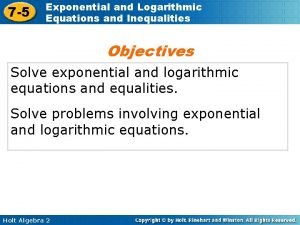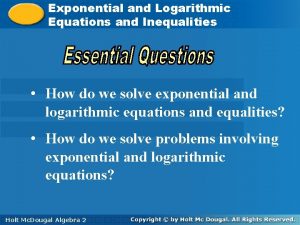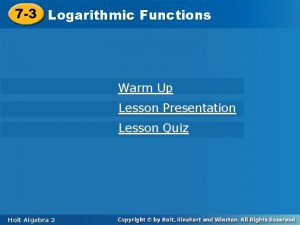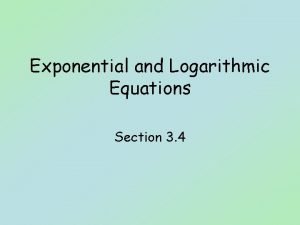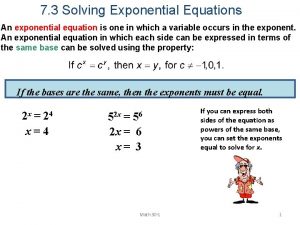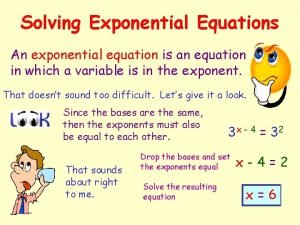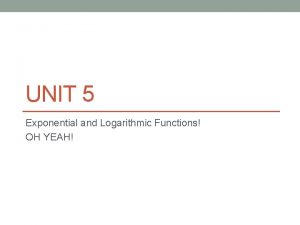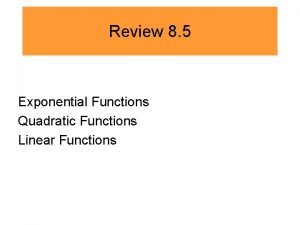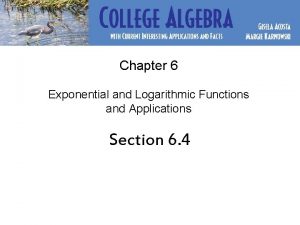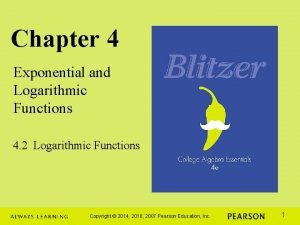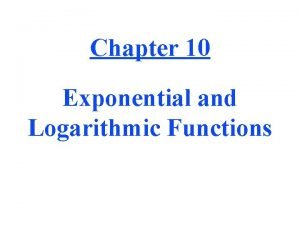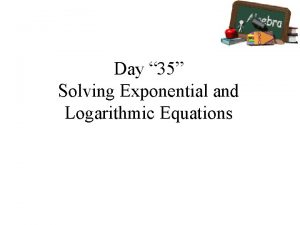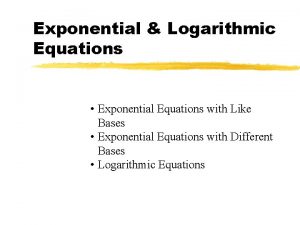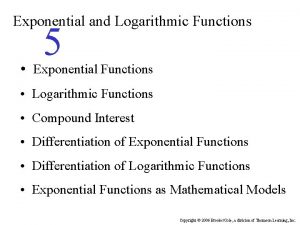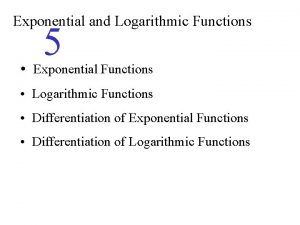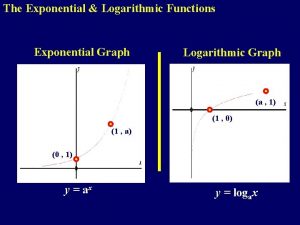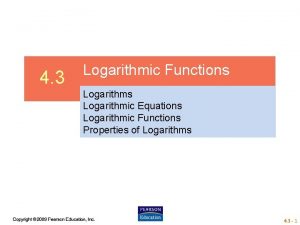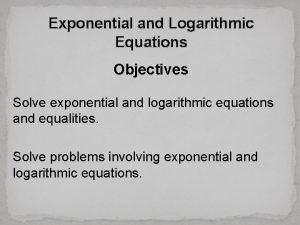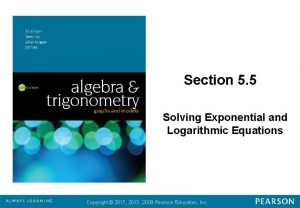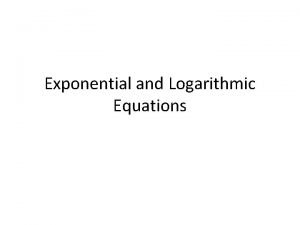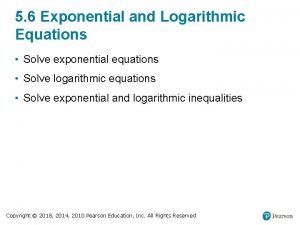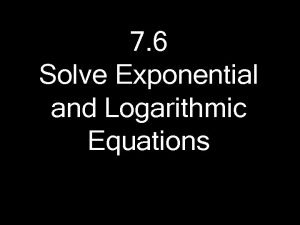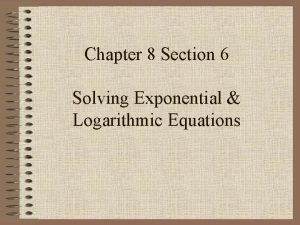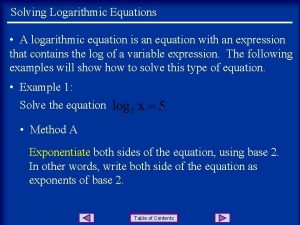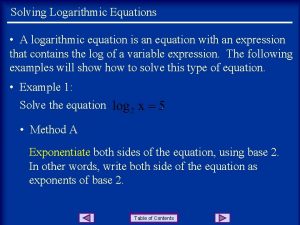SECTION 6 4 Solving Exponential and Logarithmic Equations
































- Slides: 32

SECTION 6. 4 Solving Exponential and Logarithmic Equations Copyright © Cengage Learning. All rights reserved.

Learning Objectives 1 State and use the rules of logarithms 2 Solve exponential equations using logarithms and interpret the real-world meaning of the results 3 Solve logarithmic equations using exponentiation and interpret the real-world meaning of the results 2

Logarithms 3

Logarithmic Functions The symbol log is short for logarithm, and the two are used interchangeably. The equation y = logb(x), which we read “y equals log base b of x, ” means “y is the exponent we place on b to get x. ” We can also think of it as answering the question “What exponent on b is necessary to get x ? ” That is, y is the number that makes the equation by = x true. 4

Logarithmic Functions A logarithmic function is the inverse of an exponential function. So if x is the independent variable and y is the dependent variable for the logarithmic function, then y is the independent variable and x is the dependent variable for the corresponding exponential function. 5

Logarithmic Functions In other words: 6

Example 1 – Evaluating a Logarithm a. Find the value of y given that b. Estimate the value of y given that Solution: a. answers the question: “What exponent do we place on 3 to get 81? ” That is, what value of y makes the equation 3 y = 81 true? Since 34 = 81, y = 4. Symbolically, we write log 3(81) = 4 and say the “log base 3 of 81 is 4. ” 7

Example 1 – Solution b. cont’d answers the question: “What exponent do we place on 4 to get 50? ” That is, what value of y makes the equation 4 y = 50 true? The answer to this question is not a whole number. Since 42 = 16, 43 = 64, we know y is a number between 2 and 3. 8

Rules of Logarithms 9

Rules of Logarithms When equations involving logarithms become more complex, we use established rules of logarithms to manipulate or simplify the equations. There are two keys to understanding these rules; 1. ) Logarithms are exponents. Thus, the rules of logarithms come from the properties of exponents. 2. ) Any number may be written as an exponential of any base. 10

Rules of Logarithms 11

Example 4 – Rule #5 The total annual health-related costs in the United States in billions of dollars may be modeled by the function where t is the number of years since 1960. According to the model, when will health-related costs in the United States reach 250 billion dollars? Solution: 12

Example 4 – Solution cont’d According to the model, 21. 66 years after 1960 (8 months into 1982), the health-related costs in the United States reached 250 billion dollars. 13

Common and Natural Logarithms 14

Common and Natural Logarithms Although any positive number other than 1 may be used as a base for a logarithm, there are two bases that are used so frequently that they have special names. A base-10 logarithm, log 10(x), is called the common log. When writing the common log, it is customary to omit the “ 10” and simply write log(x). Thus, y = log(x) means “What exponent on 10 gives us x? ” The answer is “y is the exponent on 10 that gives us x (x = 10 y). ” 15

Common and Natural Logarithms A base-e logarithm, loge(x), is called the natural log (so named because e 2. 71828 is called the natural number). When writing the natural log we write ln(x) instead of loge(x). Thus, y = ln(x) asks “What exponent on e gives us x? ” and the answer is “y is the exponent on e that gives us x (x = ey). ” 16

Common and Natural Logarithms 17

Example 5 – Using Common and Natural Logs Evaluate each of the following expressions: 18

Example 5 – Solution a. b. 19

Example 5 – Solution cont’d c. d. 20

Finding Logarithms Using a Calculator 21

Finding Logarithms Using a Calculator When logarithms do not evaluate to integers, a calculator can help us find accurate decimal approximations. We use the and buttons on the calculator to find the common and natural logs of any number. 22

Example 6 – Calculating Exact Logarithms Use a calculator to find log(600) and ln(100). Then interpret and check your answers. Solution: Using a calculator, we get the results shown in Figure 6. 12. This tells us that 102. 778 600 and e 4. 605 100. Figure 6. 12 23

Finding Logarithms Using a Calculator Unfortunately, some calculators are not programmed to calculate logarithms of other bases, such as log 3(17). However, using the rules of logarithms we can change the base of any logarithm and make it a common or natural logarithm. 24

Example 7 – Changing the Base of a Logarithm Using the rules of logarithms, solve the logarithmic equation y = log 3(17). Solution: We know from the definition of a logarithm y = log 3(17) means 3 y = 17. We also know 2 < y < 3 since 32 = 9, 33 = 27, and 9 < 17 < 27. To determine the exact value for y we apply the change of base formula. 25

Example 7 – Solution cont’d This tells us that log 3(17) 2. 579, so 32. 579 17. The same formula can be used with natural logs, yielding the same result. 26

Solving Exponential and Logarithmic Equations 27

Example 8 – Solving an Exponential Equation The populations of India, I, and China, C, can be modeled using the exponential functions and where t is in years since 2005. According to these models, when will the populations of the two countries be equal? Solution: We set the model equations equal to each other and solve for t. 28

Example 8 – Solution cont’d 29

Example 8 – Solution cont’d Almost 23 years after 2005, or just before the end of 2028, we expect China and India to have the same population. 30

Example 9 – Solving a Logarithmic Equation Solve the equation for x. Solution: 31

Solving Exponential and Logarithmic Equations For some students, logarithms are confusing. The following box gives a list of common student errors when using logarithms. 32
 Site:slidetodoc.com
Site:slidetodoc.com 7-5 exponential and logarithmic equations and inequalities
7-5 exponential and logarithmic equations and inequalities Log to exponential
Log to exponential 4-5 exponential and logarithmic equations and inequalities
4-5 exponential and logarithmic equations and inequalities Logarithmic function equation and inequalities
Logarithmic function equation and inequalities Exponential and logarithmic equations and inequalities
Exponential and logarithmic equations and inequalities Solving exponential and logarithmic functions calculator
Solving exponential and logarithmic functions calculator Log to exponential form
Log to exponential form Log form to exponential form
Log form to exponential form 3-4 exponential and logarithmic equations
3-4 exponential and logarithmic equations 3-4 exponential and logarithmic equations
3-4 exponential and logarithmic equations 3-4 exponential and logarithmic equations
3-4 exponential and logarithmic equations 3-4 exponential and logarithmic equations
3-4 exponential and logarithmic equations Solving logarithmic equations
Solving logarithmic equations Logarithm formula
Logarithm formula Solving for exponents
Solving for exponents Solving exponential equations with different bases
Solving exponential equations with different bases Unit 8 exponential and logarithmic functions
Unit 8 exponential and logarithmic functions Unit 5 exponential and logarithmic functions answers
Unit 5 exponential and logarithmic functions answers Examples of linear quadratic and exponential functions
Examples of linear quadratic and exponential functions Chapter 6 exponential and logarithmic functions answers
Chapter 6 exponential and logarithmic functions answers Chapter 4 exponential and logarithmic functions
Chapter 4 exponential and logarithmic functions Exponential function form
Exponential function form Property of equality for exponential functions
Property of equality for exponential functions Curve fitting with exponential and logarithmic models
Curve fitting with exponential and logarithmic models Transforming exponential and logarithmic functions
Transforming exponential and logarithmic functions The inverse of exponential function is a composite function
The inverse of exponential function is a composite function Chapter 5 exponential and logarithmic functions
Chapter 5 exponential and logarithmic functions Expanding logarithmic functions
Expanding logarithmic functions Chapter 9 exponential and logarithmic functions answer key
Chapter 9 exponential and logarithmic functions answer key Chapter 9 exponential and logarithmic functions answer key
Chapter 9 exponential and logarithmic functions answer key Chapter 5 exponential and logarithmic functions answer key
Chapter 5 exponential and logarithmic functions answer key Exponential inequality definition
Exponential inequality definition


